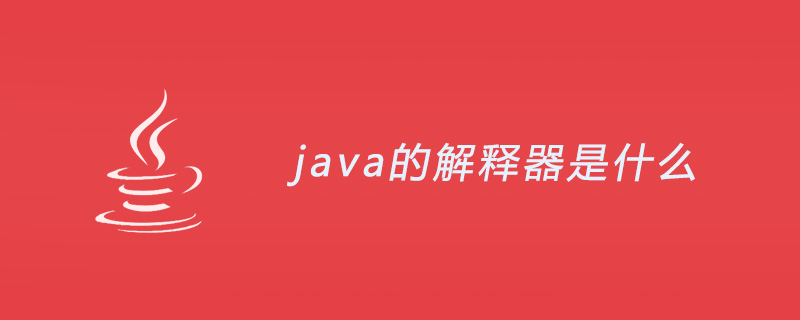What is the interpreter of java

The Java interpreter is part of the JVM. The Java interpreter is used to interpret and execute programs compiled by the Java compiler. java.exe can simply be thought of as a Java interpreter.
The role of the java interpreter
When compiling a .java file, we will get an output file with the exact same name; but for each file in the .java file Classes, they all have a .class extension. Therefore, we may end up with a large number of .class files from a small number of .java files. If you have written programs in an assembly language before, you may be used to the compiler first splitting out a transitional form (usually an .obj file), and then using a linker to encapsulate it with other things (generating a executable file), or packaged with a library (generating a library). But that's not how Java works. A valid program is a series of .class files that can be encapsulated and compressed into a JAR file (using the jar tool provided by Java 1.1). The Java interpreter is responsible for finding, loading and interpreting these files.
The running process of the java interpreter:
First find out the environment variable CLASSPATH configured when installing the JDK before. JDK after 1.8.0 will automatically configure environment variables.
CLASSPATH contains one or more directories that are used as the root directory for finding .class files. Starting from the root directory, the interpreter takes the name of the package and replaces each period (.) with a backslash (\) to produce a pathname from the CLASSPATH root (aa.bb.cc becomes aa\bb\cc or aa/bb/cc or other, depending on the OS).
The obtained path will be connected to various items in CLASSPATH. The interpreter will store the .class file related to the class name you want to create in these directories.
The above is the detailed content of What is the interpreter of java. For more information, please follow other related articles on the PHP Chinese website!

Hot AI Tools

Undresser.AI Undress
AI-powered app for creating realistic nude photos

AI Clothes Remover
Online AI tool for removing clothes from photos.

Undress AI Tool
Undress images for free

Clothoff.io
AI clothes remover

AI Hentai Generator
Generate AI Hentai for free.

Hot Article

Hot Tools

Notepad++7.3.1
Easy-to-use and free code editor

SublimeText3 Chinese version
Chinese version, very easy to use

Zend Studio 13.0.1
Powerful PHP integrated development environment

Dreamweaver CS6
Visual web development tools

SublimeText3 Mac version
God-level code editing software (SublimeText3)

Hot Topics
 Square Root in Java
Aug 30, 2024 pm 04:26 PM
Square Root in Java
Aug 30, 2024 pm 04:26 PM
Guide to Square Root in Java. Here we discuss how Square Root works in Java with example and its code implementation respectively.
 Perfect Number in Java
Aug 30, 2024 pm 04:28 PM
Perfect Number in Java
Aug 30, 2024 pm 04:28 PM
Guide to Perfect Number in Java. Here we discuss the Definition, How to check Perfect number in Java?, examples with code implementation.
 Random Number Generator in Java
Aug 30, 2024 pm 04:27 PM
Random Number Generator in Java
Aug 30, 2024 pm 04:27 PM
Guide to Random Number Generator in Java. Here we discuss Functions in Java with examples and two different Generators with ther examples.
 Armstrong Number in Java
Aug 30, 2024 pm 04:26 PM
Armstrong Number in Java
Aug 30, 2024 pm 04:26 PM
Guide to the Armstrong Number in Java. Here we discuss an introduction to Armstrong's number in java along with some of the code.
 Weka in Java
Aug 30, 2024 pm 04:28 PM
Weka in Java
Aug 30, 2024 pm 04:28 PM
Guide to Weka in Java. Here we discuss the Introduction, how to use weka java, the type of platform, and advantages with examples.
 Smith Number in Java
Aug 30, 2024 pm 04:28 PM
Smith Number in Java
Aug 30, 2024 pm 04:28 PM
Guide to Smith Number in Java. Here we discuss the Definition, How to check smith number in Java? example with code implementation.
 Java Spring Interview Questions
Aug 30, 2024 pm 04:29 PM
Java Spring Interview Questions
Aug 30, 2024 pm 04:29 PM
In this article, we have kept the most asked Java Spring Interview Questions with their detailed answers. So that you can crack the interview.
 Break or return from Java 8 stream forEach?
Feb 07, 2025 pm 12:09 PM
Break or return from Java 8 stream forEach?
Feb 07, 2025 pm 12:09 PM
Java 8 introduces the Stream API, providing a powerful and expressive way to process data collections. However, a common question when using Stream is: How to break or return from a forEach operation? Traditional loops allow for early interruption or return, but Stream's forEach method does not directly support this method. This article will explain the reasons and explore alternative methods for implementing premature termination in Stream processing systems. Further reading: Java Stream API improvements Understand Stream forEach The forEach method is a terminal operation that performs one operation on each element in the Stream. Its design intention is






